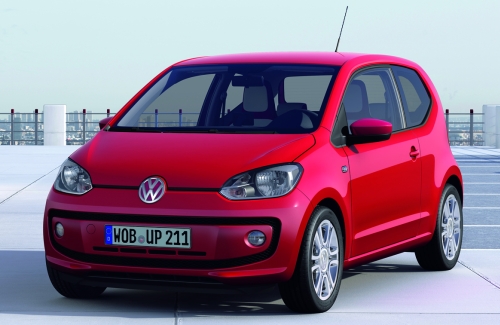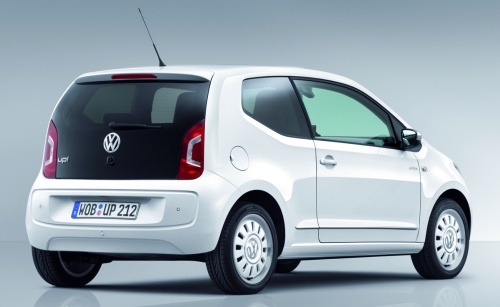Volkswagen’s new small car, the up!, will be launched in Europe in December. At point of entry, there will be three versions to cater for different budgets and needs – the take up! is the entry-level car, move up! the comfort-oriented one and high up! the top of the range version. The market launch will also see two independent models based on the high up!, these being the up! black and the up! white.
The new car will also see the debut of a new three-cylinder 1.0 litre petrol engine, initially in two output guises, these being 60 PS and 75 PS. In its BlueMotion Technology form, with a Stop/Start system, the up! promises 4.2 l per 100 km (60 PS) and 4.3 l per 100 km (75 PS) in fuel consumption.
As it goes along, a natural gas engine with 68 PS with the same basic configuration is set to follow, and there are also definite plans for an up! with an electric drive to be introduced in 2013.
Smaller than the Polo, the up! is very much catered for urban use, with a maximum utilisation of space being the operative word. At 3.54 m long, 1.64 m wide and 1.48 m tall, the company says that the up! is one of the smallest four-seat cars around, but with conspicuously short body overhangs and a very long wheelbase (2.42 m) the car has a body layout that fully utilises the space available in the new design.
The long wheelbase, combined with an engine that is mounted well forward, means that the interior is decently sizeable – the car seats four comfortably, with 251 litres of boot space left over. With the rear seat fully folded, cargo space increases to 951 litres.
The cabin will be cleanly laid-out, and Veedub says that the interior will offer numerous clever and detailed solutions, fun styling and a level of quality that will “enhance the market segment.” Depending on the equipment line, either decor paint or one of the five body colours available for the car will be used in the interior.
Features will include what is called a Dash Pad, an instrument pad extending crosswise in front of the driver and front passenger. Elsewhere, a maps + more system will be offered, as part of a mobile Portable Infotainment Device (PID). The user simply snaps the PID into place above the centre console, and navigation, telephone and infotainment can now be controlled and viewed via the PID touchscreen.
The touchscreen can also be used to view important vehicle information, such as the visual display of the ParkPilot, which controls the car’s distance to the next vehicle. Apps specially developed for the up! also let users extend maps + more to meet their specific needs.
In terms of customisation, optional features include up! boxes, which are box sets for shopping, long trips or for children on board. There’s the “kid box”, for example, which is designed for parents with small children – it includes a bag for the thousand small items that are essential with small children, as well as a toy to cuddle and a lunch box for the obligatory snacks. Other up! boxes will be called the “city box” and the “travel box.”
Elsewhere, among the other items on the options list for the car is City Emergency Braking, which features automatic braking intervention. Automatically active at speeds under 30 km/h, the system utilises a laser sensor to detect the risk of an imminent collision. VW says the up! is the only vehicle in the segment to be offered with an emergency braking function for city driving.
[zenphotopress number=999 album=2563]
Looking to sell your car? Sell it with Carro.





















AI-generated Summary ✨
Comments on the Volkswagen Up! focus mainly on its design, with some comparing it to other small cars like the Proton Emas and Myvi, noting similarities in front and rear styling. Several express disappointment or skepticism about the car's aesthetics, branding, and whether it will reach markets like Malaysia due to high taxes and pricing. Some comments highlight VW's reputation for quality and design, praising the Up! as a well-designed vehicle, while others mock its name and appearance, calling it "girly" or "cute." There is also discussion about the car's competitive edge over local models and comments on market strategies, import costs, and the car's potential for local manufacturing. Overall, sentiments range from admiration to skepticism, with some highlighting the car's quality and others critiquing its looks and market presence.